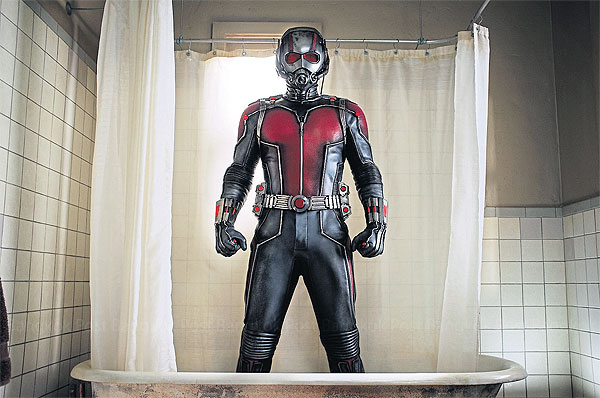The platitudes have started to trickle in. "Less is more" is the most frequently heard, followed by perhaps "size doesn't matter", though, of course, we can also resort to simpler expressions of wonderment, like "do we have to watch another Marvel movie?" or "is world domination being plotted by Thanos or by Marvel?"
This week we have Ant-Man, the final film in Phase Two of Marvel Studios' three-phase roll-out of superhero gargantuan proportions that will continue until Thailand has an election, sorry, I mean until May 2019 — four years from now.
A small consolation from the prospect of this near-megalomania is that Ant-Man is at least entertaining without overwhelming, and funny without the pomposity of the recent Marvel onslaught. Less is not actually more — less is tolerable, less is relief in the season of Brobdingnagian stampede.
Paul Rudd plays Scott Lang, a Robin Hood-like burglar who becomes Ant-Man under the tutelage of Michael Douglas' Dr Hank Pym, fatherly and professorial. Slipping into a 1960s red-and-silver vintage suit and insectoid mask, Lang shrinks himself to bug-size while his punch packs the density of a heavyweight. The villain here is Darren Cross/Yellowjacket (Corey Stoll), Pym's former student who's turned into a typically power-crazed creep, and yes, that perennial nuisance Hydra also dip its toes into the mayhem here.
Through Pym's neuro-entomological invention, Ant-Man can communicate with ants and rally the swarms to help him in missions, from constructing ant-bridges, ant-rafts, ant-helicopters, to blocking bullets and short-circuiting a corporate mainframe.
In fact, some of the best visuals in Ant-Man come when we see things from the Lilliputian perspective of the ants, when everyday objects like water pipes, air ducts or carpet yarns become supernatural landscapes, or when the fight scenes between Ant-Man and Yellojacket (Corey Stoll) take place in a locked briefcase and on top of Thomas & Friends toy trains. There's something old-fashioned and childlike — say Inner Space (1987) or The Incredible Shrinking Man (1957) — about the sci-fi scenario of tiny humans in an oversized world, and Ant-Man updates that with deft and humour.
And the humour here is silly, meaning it often works. As the superhero universe expands, the Marvel films often try to appear as if they don't take themselves too seriously, that the saviours of mankind, like Iron Man and Thor, can laugh at themselves and that there's a sense of self-knowing in their patented arrogance. That, too, worked in the beginning, but the jokes have become laborious and even phony in subsequent films, such as Avengers 2. In Ant-Man, the humour is candid, street-wise, and does not rely on just one-liner quips preferred by Tony Stark or Thor; here the gags mostly come from Ant-Man's sidekicks, a trio of petty thieves of various ethnicities and accents (Michael Pina, David Dastmalchian and rapper T.I.). They're also normal humans with no special powers, which is a change.
Rudd himself is an unlikely superhero. Slight, sweet and playful, he first responds to Pym's decision to turn him into Ant-Man and go against the villain with a sensible expression: "I think we should call the Avengers." Oh yeah. In fact, the Avengers will call on him (he'll appear in the next Captain America film next year, at least), and though Ant-Man feels modest and casual compared to other stuffy superhero films of late, it's still framed as part of the grandiose design of the Marvel cosmology — meaning that this tiny, pretty likeable hero is about to be subsumed into the roaring currents. For better or worse, size does matter after all.

